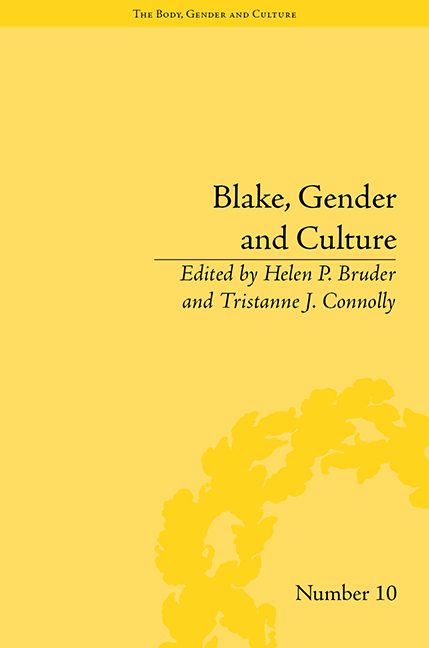Book contents
- Frontmatter
- CONTENTS
- Acknowledgements
- List of Contributors
- List of Figures
- Abbreviations
- Introduction: Naked History Displayed
- 1 ‘Merely a Superior Being’: Blake and the Creations of Eve
- 2 The Last Strumpet: Harlotry and Hermaphroditism in Blake's Rahab
- 3 Sex, Violence and the History of this World: Blake's Illustrations to the Book of Enoch
- 4 Bridal Mysticism and ‘Sifting Time’: The Lost Moravian History of Blake's Family
- 5 ‘A Secret Common to Our Blood’: The Visionary Erotic Heritage of Blake, Thomas Butts and Mary Butts
- 6 Changing the Sexual Garments: The Regeneration of Sexuality in Jerusalem
- 7 Philoprogenitive Blake
- 8 ‘Seeking Flowers to Comfort Her’: Queer Botany in Blake's Visions, Darwin's Loves and Wollstonecraft's Rights of Woman
- 9 ‘Or Wilt Thou Go Ask the Mole?’: (Con)Figuring the Feminine in Blake's Thel
- 10 Gendering the Margins of Gray: Blake, Classical Visual Culture and the Alternative Bodies of Ann Flaxman's Book
- 11 The Virgil Woodcuts Out of Scale: Blake's Gigantic, Masculine Pastoral
- 12 Closet Drama: Gender and Performance in Blake and Joanna Baillie
- Notes
- Works Cited
- Index
2 - The Last Strumpet: Harlotry and Hermaphroditism in Blake's Rahab
- Frontmatter
- CONTENTS
- Acknowledgements
- List of Contributors
- List of Figures
- Abbreviations
- Introduction: Naked History Displayed
- 1 ‘Merely a Superior Being’: Blake and the Creations of Eve
- 2 The Last Strumpet: Harlotry and Hermaphroditism in Blake's Rahab
- 3 Sex, Violence and the History of this World: Blake's Illustrations to the Book of Enoch
- 4 Bridal Mysticism and ‘Sifting Time’: The Lost Moravian History of Blake's Family
- 5 ‘A Secret Common to Our Blood’: The Visionary Erotic Heritage of Blake, Thomas Butts and Mary Butts
- 6 Changing the Sexual Garments: The Regeneration of Sexuality in Jerusalem
- 7 Philoprogenitive Blake
- 8 ‘Seeking Flowers to Comfort Her’: Queer Botany in Blake's Visions, Darwin's Loves and Wollstonecraft's Rights of Woman
- 9 ‘Or Wilt Thou Go Ask the Mole?’: (Con)Figuring the Feminine in Blake's Thel
- 10 Gendering the Margins of Gray: Blake, Classical Visual Culture and the Alternative Bodies of Ann Flaxman's Book
- 11 The Virgil Woodcuts Out of Scale: Blake's Gigantic, Masculine Pastoral
- 12 Closet Drama: Gender and Performance in Blake and Joanna Baillie
- Notes
- Works Cited
- Index
Summary
Rahab, the complete body of Mystery which is also the sign of apocalypse: what the author of Finnegans Wake might have called the Last Strumpet or the Great Whorn.
– Northrop Frye, Fearful Symmetry (1947)It is this larger issue of authority and subversion that the hermaphrodite comes to exemplify. Not merely an image of sexual confusion … the hermaphrodite becomes an image of social disorder and civil strife.
– Kathleen Long, Hermaphrodites in Renaissance Europe (2006)Rahab is a powerful and largely malignant figure in Blake's epic prophecies. She makes her debut in the major revisions that transform Vala into The Four Zoas (1797–c. 1807), turning the nature goddess Vala into the female aspect of a hermaphroditic creature that Blake identifies with the Babylon harlot in John's Apocalypse. Although Rahab occupies a distinct role and develops a unique character in The Four Zoas, she retains a number of symbolic features in Milton and Jerusalem: she is named Mystery Babylon, she plays the harlot with the kings of the earth, she wields the cup of religion, and she crucifies the Lamb of God. Also, in each epic she represents the alliance of religion and empire which Blake symbolizes as a harlot and dragon and encodes in the phrase ‘Religion hid in War’ (M 37:43, E138; J 75:20, 89:53, E231, 249). Emerging alongside the more conventional figures of Satan, the Lamb of God and Jerusalem, Rahab is not just crucial to Blake's later symbolism but arguably his most original creation.
- Type
- Chapter
- Information
- Blake, Gender and Culture , pp. 25 - 36Publisher: Pickering & ChattoFirst published in: 2014



